ETSI algorithms & codes service assigns and manages codes for various technologies. These codes are used by the communications industry to convey information about systems and equipment.
The administrative cost for each single code is €150 (VAT excluded / administrative fees included).
Customers wishing to purchase codes must sign a Confidentiality Usage Undertaking form (CRUU) and demonstrate they fulfil the specified approval conditions.
ETSI’s Centre for Testing and Interoperability (CTI) also assigns and registers codes for ETSI Technical Bodies. These specific codes do not require any of the specific approval conditions of the CRUU, nor do they involve any payment.
How to order and pay for a code
This is a two step process. The order is separate from the payment. Payment and CRUU duly completed and signed are necessary to obtain the code(s).
Open ![]() the PDF to ORDER and watch
the PDF to ORDER and watch ![]() the video for all details on how to fill in the CRUU and how to PAY.
the video for all details on how to fill in the CRUU and how to PAY.
View ![]() this video on how to PAY or click here to access our online payment platform.
this video on how to PAY or click here to access our online payment platform.
Non-public codes
DECTTM EIC / DECTTM EMC / DECTTM POC and TETRATM TAC are undisclosed codes distributed by ETSI.
Information related to these codes can be found in the following specifications:
- DECTTM EIC (Equipment Installer’s Code): EN 300 175-6.
- DECTTM EMC (Equipment Manufacturer Code): EN 300 175-6.
- DECTTM POC (Public Operator Code): EN 300 175-6.
- TETRATMTAC (Type Approval Code): EN 300 392-2.
For further information, please contact Algorithms & codes service.
Public codes
DMR / TETRATM FAC / TETRATM Location System Coding scheme / TETRATM proprietary AT / TETRATM proprietary element owner and TETRATM SDS-TL are distributed by ETSI.
The list of public codes already assigned can be consulted here.
Information related to these codes can be found in the following specifications:
- DMR (Digital Mobile Radio) MFID: TS 102 361-1.
- TETRATM FAC (Final Assembly Code): EN 300 392-2.
- TETRATM Location System Coding scheme (Equipment Manufacturer Code): EN 300 392-2.
- TETRATM proprietary AT command name family: TS 100 392-5.
- TETRATM proprietary element owner: EN 300 392-2.
- TETRATM SDS-TL protocol identifier: EN 300 392-2.
For further information, please contact Algorithms & codes service.
Protocol Naming and Numbering Service
ETSI’s Centre for Testing and Interoperability (CTI) assigns and registers ASN.1 object identifiers, protocol numbers, XML and URI namespaces, etc. for all ETSI Technical Bodies (TBs). ETSI CTI also allocates CNI codes for the broadcast industry.
Many protocols require the allocation of globally unique names or numbers in order to interoperate successfully. Ranges of names or numbers are often allocated to standards bodies in order to distribute the task of allocation, while still maintaining global uniqueness.
In addition, ETSI CTI can manage, on behalf of an ETSI TB, a request for a protocol name or number allocation from another issuing authority. For example, allocations of Network Management Parameters or allocations for Diameter, XCAP, H.248 protocols can be managed.
All details related to these codes can be found on the Protocol Naming and Numbering page on the ETSI Portal.
To request one of these codes, please contact CTI_Support@etsi.org.
]]>Questions about the application process and payment
BECOMING A MEMBER
For enquiries related to becoming an ETSI member, please contact our Director for Membership Development.
EXISTING MEMBERSHIP
For enquiries related to an existing ETSI membership, please contact the ETSI membership team by e-mail, phone or fax:
membership@etsi.org
Tel: +33 (0)4 92 94 42 69
Fax: +33 (0)4 93 65 47 16 (mark for the attention of Membership)
You can apply online and then follow the instructions
The application must be submitted online. If you don’t have an ETSI Online account, you will need to request one via the same link to proceed with your application.
The person authorized to sign such legal documents on behalf of an organization. The Membership Agreement with annexed application form is sent for signature to the person you have indicated as "Legal contact".
The person authorized to sign such legal documents on behalf of an organization.The signature on the application engages a member to comply with the ETSI Directives and the decisions of the General Assembly and to pay the yearly contribution. Therefore, the person who signs should be authorized within the organization to ensure that this engagement is respected. e.g. the head of division or head of section depending on how authority is delegated within your organization.
Membership of ETSI is approved by obtaining consensus among the ETSI Full and Associate members via an online poll organized four times per year, subject to the payment of the member contribution or observer fee prior to the poll submission and calculated on a pro-rata basis - depending on when the application is registered by the ETSI Secretariat (see our contributions page).
The different membership categories of ETSI are described in the ETSI Rules of Procedure, Annex 1, contained in the ETSI Directives.
Administrations: For the purposes of the present Rules of Procedure “Administration” refers to the specific department, agency or other organization empowered by a public authority or a government to act on its behalf, and financially contributing to the ETSI budget according to the latest available figure of the GDP of their country as specified in Annex 2 of the RoP. This financially contributing organization is usually the department leading on electronic communications and digital technical standards for the government.
Other Governmental Bodies: Central government departments, local government departments, public institutions, public authorities (agencies, corporations etc.) that function separately from the department that pays the Administrations membership.
National Standards Organizations: Organizations whose function is to carry out at national level the activities related to Standstill, Public Enquiry, establishment of the national position for the vote on draft European Standards as well as the transposition and withdrawal of national standards. These organizations are recognized by their governments as being authorized to make those standards available to the public at the national level.
Consultancy Companies/Partnerships: Legally established entities that provide professional expertise in relation to electronics communications and related areas.
An association or organization of such Consultancy Companies/Partnerships also falls within this category.
Manufacturers: Companies developing and/or producing and/or installing and/or maintaining products to be used in, or directly or indirectly connected to, an electronics communications network.
An association or organization of such Manufacturers also falls within this category.
Network Operators: Operators of an electronics communications network or part thereof.
An association or organization of such Network Operators also falls within this category.
Research Bodies: Establishment performing research related to electronics communications and related areas. A Public Research Body is a not-for-profit research organization whose majority ownership is within the public sector.
Service Providers: Companies providing service(s) on a commercial basis to third parties.
An association or organization of such Service Providers also falls within this category.
Universities: Institutions for higher education or postgraduate training having the legal power to award first and/or higher degrees.
An association or organization of Universities also falls within this category.
Users: Organizations making use of services in the field of electronics communications and related areas, whose main interest in electronics communications standards is in that capacity.
An association or organization of such Users also falls within this category.
The financial contribution of an ETSI member is not based on your participation in specific technical work, when you become a member you have access to all ETSI technical resources and work. Only the participation in 3GPP is subject to an extra fee for members in class of contribution 1 or 2.
Members’ contributions are calculated by class. Each class corresponds to an annual contribution/fee payable and a related voting weight.
Associations, Users not-for-profit Associations (end consumers), National Standards Organizations (NSOs), Universities, Public Research Bodies, Small and Medium-sized Enterprises (SME) and Micro-Enterprises correspond to class of contribution 1 with a flat fee.
Otherwise, the class is derived from the member company's annual ECRT or GDP for Administrations.
The contribution is based on your organization's annual Electronic Communications Related Turnover (ECRT) (or the Gross Domestic Product (GDP) of the country for administrations responsible for electronics communications and related areas of their country).
For a detailed breakdown of the classes of contribution, see the contributions page.
ECRT is your Electronic Communications Related Turnover. A member organization's ECRT is defined as the worldwide turnover generated by all the member's products and services related to Article 2 'Purpose' and Article 3 'Scope of activities' of the ETSI Statutes. ECRT is your Electronic Communications Related Turnover. A member organization's ECRT is defined as the worldwide turnover generated by all the member's products and services related to Article 2 'Purpose' and Article 3 'Scope of activities' of the ETSI Statutes. The ECRT for an organization must be updated on a yearly basis.
When considering what ECRT to declare, members should take into consideration the entire turnover related to electronic communications related products, components and services, regardless of technology or standard used (e.g. WiFi and Bluetooth technologies are included). It includes sales of communications equipment, and sales of communications-related services or systems (network management, communications intelligence). Or alternatively sales to communication service providers. Gross turnover or revenue, and not net income, should be considered. When considering what ECRT to declare, members should take into consideration the entire turnover related to electronic communications related products, components and services, regardless of technology or standard used (e.g. WiFi and Bluetooth technologies are included). It includes sales of communications equipment, and sales of communications-related services or systems (network management, communications intelligence). Or alternatively sales to communication service providers. Gross turnover or revenue, and not net income, should be considered.
The Rules of Procedure, Annex 2, clause 6f) state that where a Member company is part of a corporate group, the ECRT is based upon the worldwide turnover generated by the entire corporate group's products and services related to electronic communications, not simply that of the Member company.
Where more than one company from a corporate group is an ETSI Member, the sum of ECRTs declared by these companies shall be equal to or greater than the ECRT calculated on the basis of the entire corporate group.
If your organization's ECRT cannot be determined from publicly available information, you will need to agree an appropriate class of contribution with the Director General.
For an Administration responsible for electronics communications and related areas of their country, the class of contribution is determined according to the latest published or available figure of the Gross Domestic Product (GDP) of its country. Reference World Bank.
Governmental organizations shall declare the latest GDP figures of their country and update that figure on a yearly basis. Governmental organizations shall declare the latest GDP figures of their country and update that figure on a yearly basis.
The member contribution payable for governmental organizations is available on the contributions page.
In accordance with Article 10.3 of the Rules of Procedure, and to ensure a correct application of the appropriate contribution scheme, each Full or Associate member shall declare or confirm to the Director-General, at least once a year, its current legal and financial situation. Any change to this situation shall be declared to the Director-General without delay.
The amount due for a given year is based on your organization's status as on the 30th September of the prior year.
The Secretariat will remind you during the summer months to declare your ECRT or GDP before the 30th September.
Applicants for membership are requested to make their payment on receipt of a pro-forma invoice. The payment must be received by ETSI prior to the submission of the application to the member online poll. If the payment is not received within 90 days of the application the said application will be suspended.
The member contribution is aligned to the calendar year. The invoice is sent in December year N-1 and is due on 1st January Year N. There is a 5% penalty for contributions and fees paid after 30 April. Fill information on the payment of member contributions and fees is available in Article 10 of the ETSI Rules of Procedure.The member contribution is aligned to the calendar year. The invoice is sent in December year N-1 and is due on 1st January Year N. There is a 5% penalty for contributions and fees paid after 30 April. Fill information on the payment of member contributions and fees is available in Article 10 of the ETSI Rules of Procedure.
It shall be noted that Membership will be tacitly renewed unless it is withdrawn before 30th September of the current year by the member organization (see Rules of Procedure, Article 1, clause 1.4.1 for full details).
No, it is prorated as follows:No, it is prorated as follows:
- when you apply between 1 December and 1 March and are approved at the first member online poll of the year, you are invoiced 100% of the annual member contribution or Observer fee;
- when you apply between 1 March and 1 June and are approved at the second member online poll of the year, you are invoiced 75% of the annual member contribution or Observer fee;
- when you apply between 1 June and 1 September and are approved at the third member online poll of the calendar year, you are invoiced 50% of the annual member contribution or Observer fee;
- when you apply between 1 September and 1 December and are approved at the fourth member online poll of the calendar year, you are invoiced 25% of the annual member contribution or Observer fee.
Our financial system is only set to Euros. You might initiate the payment in another currency, but the conversion rate should match the amount raised in Euro.
Yes, SMEs and MEs belong to class 1 and benefit from a preferential flat fee. See the contributions table on the contributions page.
Yes, universities and public research bodies belong to class 1 and benefit from a preferential flat rate. See table in the contribution page.
Yes, associations and not-for-profit user associations belong to class 1 and benefit from a preferential flat rate. See the table on the contributions page.
Cases are usually very different and for that reason you are invited to contact the membership team at membership@etsi.org
A member organization from a corporate or public group may decide to apply for an additional membership related to the same group. An additional member contributes an administrative fee (€6 300) considering that the “primary” member of the group already pays the member contribution based on the corporate group’s declared ECRT or GDP. There is no limit to the number of additional memberships within a corporate group or for an administration.
An additional member has 0 voting weights, but it may carry the voting weight associated to the Corporate or Public Group.
Fees and member contributions are excluding tax. Whether you need to pay VAT depends on your organization's VAT registration status and location. Here's how it works:
- If the organization is registered in France, VAT with the French rate of 20% applies
- If the organization is registered in the European Union and is also registered for European VAT, no VAT applies due to the EU reverse-charge rule
- If the organization is registered in the European Union but is not registered for European VAT, the 20% VAT French rate applies unless there’s an Authorities Tax Exemption Certificate
- If the organization is registered outside the European Union, no VAT applies
Yes. It is mandatory that each user of the organization has his own personal account. We will provide as many user accounts as required in order to follow all the areas of work you have an interest in.
Questions about general procedure
Yes. People will need to register their attendance under your organization’s name subject to the approval of the member organization’s official contact.
Special provisions are applicable for Associations that shall be represented in ETSI by their employees and elected officials. In addition, a maximum of one nominated technical expert, per meeting, shall be allowed to attend and participate in meetings and shall come from a Member of the said Association, unless explicitly authorized by the Director-General on a case-by-case basis.
This expert shall be officially nominated in writing by the said Association before the meeting begins. All employees, elected officials and/or nominated technical expert of an Association attending ETSI meetings shall only represent that Association’s views.
Yes, this should be provided to the Membership team.
No, your attendance at the General Assembly meeting is not mandatory but you may benefit from attending as it gives you the opportunity to express your interests and needs, participate in the management of the Institute and network with other members.
No. You will not be asked to make a presentation about your organization.
As soon as your application is validated by ETSI Director-General, you may attend meetings of technical committees, ISGs, working groups etc. You can only exercise your voting rights or hold official positions when your membership is effective (after formal approval at the quarterly online poll or at the GA).
Each user should send a request to ETSI via our User Account Application Form
To change your personal information, you can use the online form.
Only official contacts can submit a request to update his/her organization’s details.
Membership of ETSI will be tacitly renewed unless it is withdrawn by a member organization before the 30th September.
To resign your membership, please utilize either the online application on the Member Portal or send an email to the Membership team before 30th September. This ensures that your resignation takes effect at the end of the current calendar year.
Failure to do so will result in your membership remaining active until the end of the following year, and you will be required to pay the member financial contribution for that period.
ETSI's mentorship programme provides support when getting started within the ETSI community. Your organisation will be contacted upon obtention of the applicant ETSI member status. Should you need assistance getting started within ETSI, please contact: claire.desclercs@etsi.org
Please contact the ETSI membership team via membership@etsi.org
All Member contributions and Observer fees will be based on the declared position of the Member/Observer, as at the 30th September of the prior year.
You can decide to have either a group membership composed of a primary member who pays the member contribution based on the global entity ECRT and additional membership(s) who pay an administrative fee and can carry the vote of the primary member.
The ECRT is based upon the worldwide turnover generated by the entire corporate group's products and services related to electronic communications, not simply that of the Member company. See the ETSI ECRT Definition.
Participation in oneM2M is included in the contribution for full and associate ETSI members and just needs to be requested.
Contact: oneM2M@etsi.org
3GPP individual membership is subject to an extra 3GPP contribution for class 1 and class 2 members.
Where Public and Corporate Groups hold multiple 3GPP memberships, they shall make an overall contribution that exceeds 20k€ multiplied by the number of 3GPP members to be exempted from paying the 3GPP minimum contribution for each of their 3GPP individual Members.
For participation in 3GPP face-to-face meetings another fee applies, based on the selected group of attendance.
Contact: membership@etsi.org
Information on ISGs is available on this webpage or via our COMMITTEES page.
Contact: ISGsupport@etsi.org
Contact our Director for Membership Development.
| 01 - ETSI Strategy.pdf | 963.39 KB | 21/06/2023 | |||
| 02 - The ETSI Community.pdf | 1.77 MB | 21/06/2023 | |||
| 03 - Discover the ETSI Environment.pdf | 1.17 MB | 21/06/2023 | |||
| 04 - Research and Innovation.pdf | 2.23 MB | 21/06/2023 | |||
| 05 - Education about Standardization.pdf | 891.26 KB | 21/06/2023 | |||
| 06 - Legal and Governance.pdf | 1.17 MB | 21/06/2023 | |||
| 07 - Standards and Regulations.pdf | 1.56 MB | 21/06/2023 | |||
| 08 - Technical Organization .pdf | 761.61 KB | 21/06/2023 | |||
| 09 - 3GPP.pdf | 2.59 MB | 21/06/2023 | |||
| 10 - oneM2M.pdf | 1.86 MB | 21/06/2023 | |||
| 11 - Testing and Interoperability.pdf | 659.04 KB | 21/06/2023 | |||
| 12 - Specialist and Testing Task Forces.pdf | 755.74 KB | 21/06/2023 | |||
| 13 - ETSI Marketing and Events.pdf | 1.76 MB | 21/06/2023 | |||
| 14 - ETSI Seminar Online Modules.pdf | 788.98 KB | 21/06/2023 |
| Thumbs.db | 164 KB | 04/06/2025 |
IPR FAQ
Please see the answer ![]() in this document.
in this document.
Normalized patent numbers are imported from the European Patent Office (EPO) Espacenet database, these patent numbers appear in black. With the direct link to EPO’s database, it is possible to access directly all patent related information by clicking on the patent number.
Un-normalized patent numbers do not match with any number from the Espacenet database and are created manually. These numbers appear in purple so that users can easily distinguish the type of data that is displayed. These numbers might be correct, but they are not checked and they do not have link to Espacenet database.
The ETSI IPR database has a dynamic link with the European Patent Office (EPO) Espacenet database. In order to search patent numbers successfully or to disclose Standard Essential Patents (SEPs), the following information might be helpful:
a) Most of the application numbers are standardised to one format (including EP application numbers). For the majority of countries, application numbers in Espacenet are made up of the country code (2 letters - use the ISO country codes), the year of filing (4 digits), and a serial number (variable, maximum 7 digits). There is a fixed length of 13 characters in Espacenet. Where necessary, the fixed length is achieved by inserting leading zeros.
CCYYYYnnnnnnn
E.g. US application number 12/853861 can be normalized as US2010853861
CC = countrycode
YYYY = year
nnnnnn = number
b) PCT application numbers in Espacenet consist of the country code WO (2 characters) followed by the year of filing (4 digits), the country code of the country where the application was filed (2 characters) and a 5-digit serial number, adding up to a fixed length of 13 characters.
WOYYYYCCnnnnn
To find, for example, PCT application PCT/IB2007/51010, you have to type in WO2007IB51010. If you are searching for application number PCT/MX2007/000062, you should enter WO2007MX00062 (i.e. remove the leading zero).
c) There are twelve countries/organisations which use a different format. These are Australia, Germany, China, Brazil, Ukraine, Gulf Council, Hungary, India, Italy, Mexico, AIPO (African Intellectual Property Organization) and WIPO. They use application numbers made up of:
- a country code (2 letters)
- the year of filing (4 digits)
- "other" information (1 or 2 characters)
- a serial number (5 or 6 digits)
CCYYYYxxnnnnnn (between 12 to 14 characters)
Do not use dash, hyphen or underscore here, just fill in the characters in a string without any spaces. Kind codes shall not be entered (except if by following the recommendations under a), b) or c) you cannot find any patent document). Refer to Espacenet kind codes.
Further information on patent application numbering:
(Source: Espacenet)
It is best to examine the existing work in ICT related SDOs and Fora and see if there are synergies. It is possible to influence existing work in ETSI by revising existing deliverables, and also to start new deliverables in existing groups or even create new groups.
To start an ISG, first of all you need an idea for ICT standardization and a group of ETSI members who wish to bring that idea into ETSI. Once you have those initial elements contact research@etsi.org.
This depends of the maturity of the research and also the synergies the work has with existing standards activities. It is safe to say, the earlier researchers start considering related standards work, the better.
It is best to consider what standards may be required for an innovative research topic early on in the process. You can contact ETSI research helpdesk research@etsi.org at any time.
New work can be brought to existing ETSI groups or new groups can be created specially to house new research topics. To contribute work to ETSI this can be done via ETSI members as direct contribution to technical groups.
ETSI has reduced fees for “Universities, public research bodies and not-for-profit user associations” set to €2 100 per year. More information can be found in our membership section.
Standards support interoperability across technologies. They help create global markets. They enable networked development, where innovation occurs on top of existing technology platforms. ICT standards embody a ‘state of the art’ of technology development. They are an essential resource for researchers in ICT. ICT markets are shaped by standards. If ICT research should lead to new products, new services, or whole new markets, then clearly research must lead to standardization activities.
ETSI can offer to provide Letters of Support to project proposals when the scope of those projects meet certain criteria. Such criteria include the project involving several ETSI members, falling within the scope of ICT, and most importantly having the clear intention to bring research results into ETSI.
For more information contact research@etsi.org.
The full ETSI membership list can be found on our website. Simply filter the view by “Research Body (public)”, “Research Body (private)” or “University”.
This falls under the scope of the European Commission. More information about the EC funding programmes that support research and innovation projects, with links to open and upcoming calls can be found on the EC website.
See the ETSI IPR POLICY: Standards rely on technical contributions from various sources. These contributions may contain patented technologies which are commonly known as Standard Essential Patents (SEP). When it is not possible on technical grounds to make or operate equipment or methods which comply with a standard without infringing a SEP, i.e. without using technologies that are covered by one or more patents, we describe that patent as ‘essential’. More information can be found on our website.
There is guidance text on the ETSI webpages. In addition we have developed a set of teaching materials on standardization, a comprehensive textbook, “Understanding ICT Standardization: Principles and Practice”, together with an extensive set of over 380 slides to be used as teaching aids.
ETSI does not fund researchers directly, but there is certain funding available from projects such as StandICT and others.
Beyond the cost of membership to ETSI (that is greatly reduced for researchers, academics and SMEs) the real cost of participation in standards is ‘time’ and ‘invested energy’. This cost depends on your level of activity and engagement.
All of ETSI’s deliverables are available for free and can be consulted and downloaded from the standards search on our website. Search by “keywords” relating to the scope of you project.
Electricity costs are a major operational expense for telecom operators, making energy efficiency critical. Strategies like optimizing device power consumption and adjusting operational modes can significantly reduce energy use and expenses. In Passive Optical Networks (PONs), traffic volumes fluctuate rapidly, creating periods of low activity. Leveraging this, PON ports can transit to low-power modes during idle periods to conserve energy. Achieving this requires a real-time traffic load sensing system that dynamically adjusts the Optical Line Terminal (OLT) interface mode based on energy-saving scenarios, enabling a closed-loop mechanism for perception, control, and execution. Accurate traffic prediction is essential for effective energy savings. Traditional SNMP polling (15-minute intervals) is too slow for granular traffic forecasting. China Telecom addressed this by pioneering Technical Specifications for Access Network Telemetry, enabling rapid data collection via active reporting protocols (see ETSI GS F5G 011 V1.1.1 (2022‑11) and ETSI GS F5G 016 V1.1.1 (2023‑06). A Proof of Concept and experiments in a region have been performed. There is no customer complaint claimed when energy-saving is enabled, so services are not affected or the impact is small.
In April 2025, ETSI published a new Group Report (GR), ETSI GR F5G 019 (Fifth Generation Fixed Network (F5G); Fixed Network Autonomous Network level definition and evaluation), which was developed in the ETSI ISG F5G.
This document provides an evaluation basis for measuring the Autonomous Network levels (from L0 to L5) of a Fixed Network (including Optical Transport Network and the Access and Residential Networks) along with its components and workflows, and defines the evaluation methodology to score the level of a specific system in a Fixed Network.
In the week of May 19th ~ 23rd 2025, global industry and academic experts in the area of optical communication gathered in Castelldefels (Barcelona), Spain to discuss F5G-Advanced network architecture and future roadmap to F6G, and identify potential open-source implementation driven by TFS and OSL to develop PoCs of the F5G-Advanced architectures. The groups involved were ETSI SDG OSL (Software Development Group OpenSlice), SDG TFS (Software Development Group TeraFlowSDN) and ISG F5G. CTTC hosted all these meetings in its headquarters.
During this week, an open joint session between SDG OSL, SDG TFS and ISG F5G was held for the first time. The intelligent network management & control and the automatic service provisioning of the F5G Advanced networks, which contain multiple fixed network segments, becomes the common interests of these three groups.
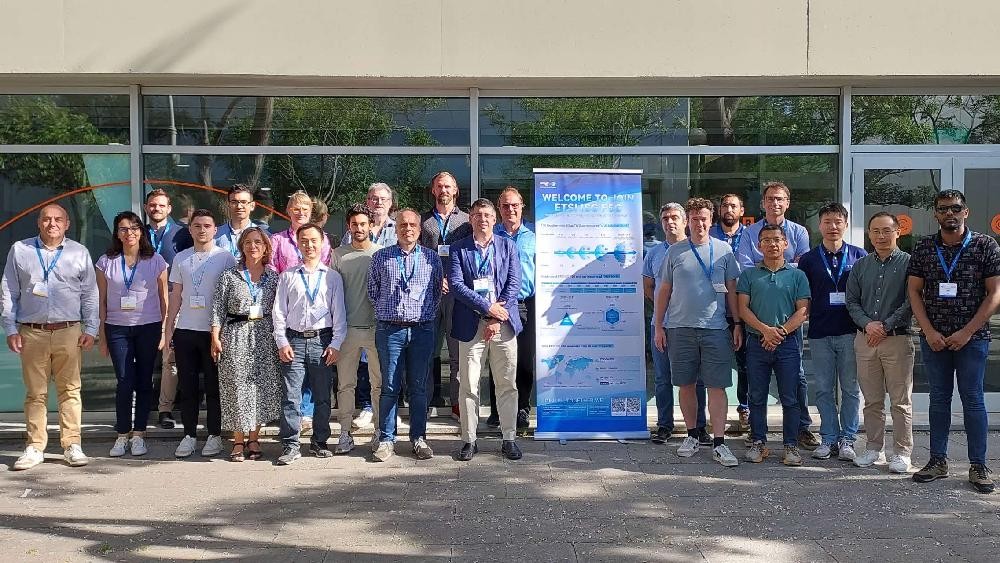
At the Mobile World Congress 2025, the Centre Tecnològic de Telecomunicacions de Catalunya (CTTC) and Huawei Technologies showcased a cutting-edge Proof of Concept (PoC) focused on the development of a standards-based and open-source Network-as-a-Service (NaaS) platform. This initiative aligns with specifications from key standards organizations such as ETSI, IETF, and CAMARA, and is built upon open-source components including ETSI TeraFlowSDN (TFS) and ETSI Open Source MANO (OSM). The proposed solution highlights the capabilities of the ETSI Industrial Specification Group (ISG) Fifth Generation Fixed (F5G) Network. This demonstration introduced a set of technical Fixed 5G technology enhancements focused on end-to-end service delivery and network automation, using an immersive Augmented Reality/Virtual Reality (AR/VR) Gaming Service for Remote Players as a practical application of the F5G Advanced (F5G-A) architecture. The platform demonstrated end-to-end QoD capabilities, incorporating application-flow classification and differentiation. To support this, the setup was expanded to include a dedicated IP transport network for best-effort traffic, operating alongside the fine-grain Optical Transport Network (fgOTN), which was used for traffic requiring guaranteed Quality of Service (QoS). This allowed the system to differentiate between traffic types and manage them accordingly.
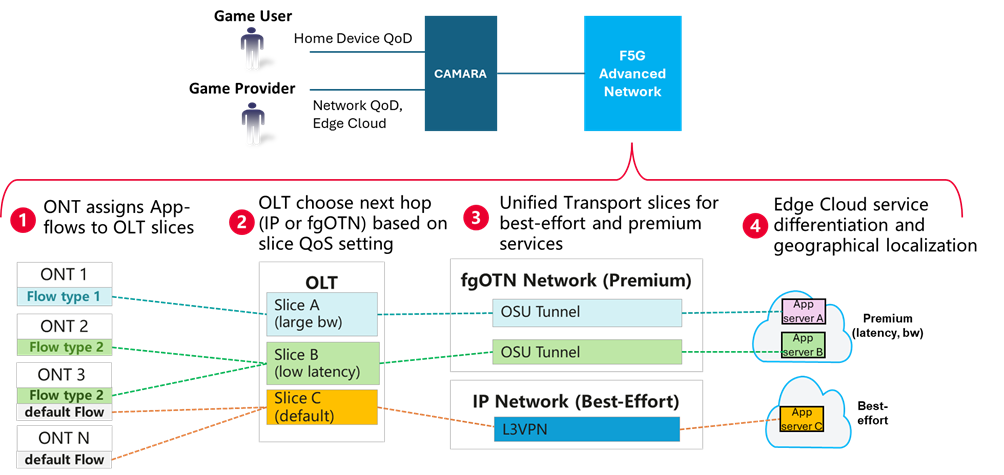
The International Telecommunication Union (ITU) and the European Telecommunications Standards Institute (ETSI) jointly organized the "ITU-ETSI Symposium on ICT Sustainability: Standards Driving Environmental Innovation", held on 11–12 December 2024 at ITU Headquarters in Geneva, Switzerland. It brought together industry leaders, policymakers, researchers and stakeholders to explore the crucial role of standards in promoting sustainable ICT practices. Standards guide the development of technologies that minimize environmental impact and enhance energy efficiency.
The ETSI Industry Specification Group (ISG) on Fifth Generation Fixed Network (F5G) releases the specification titled "Fifth Generation Fixed Network (F5G); Specification for PON based Industrial Network".
Passive Optical Network (PON) is the dominant access network technology for operators all around the world and has been widely deployed in public access networks. It has the advantages of large bandwidth, low deployment cost, uses passive optical distribution network, carrier-grade quality and smart operation and maintenance capabilities.
In the week of November 12th to 15th 2024, both the 20th ETSI ISG F5G Plenary meeting and CCSA TC6 WG2 plenary meeting were held, co-located in Jingdezhen, Jiangxi Province, China.
On November 13th 2024 during the two meetings, a workshop on "Evolution of Optical Network Generations: Technologies and Standards" was held. Six experts from both ISG F5G and CCSA TC6 WG2 shared the latest progress of technologies and standards development of optical networks. A panel discussion was held over the topics of future technologies and standard cooperation to promote the next generation of optical networks. The panellists include:
- Dr. Dechao Zhang, CCSA TC6 WG2 Vice Chair, China Mobile
- Dr. Olivier Ferveur, ETSI ISG F5G Chair, POST Luxembourg
- Dr. Jialiang Jin, ETSI ISG F5G Vice Chair, China Telecom
- Mr. Hai Ding, Network innovative product expert from China Unicom
- Ms. Qian Liu, ETSI ISG F5G TEST WG Chair, CAICT
- Dr. Raul Muñoz, Research Director, CTTC
- Dr. Marcus Brunner (Moderator), ETSI ISG F5G Vice Chair, Huawei
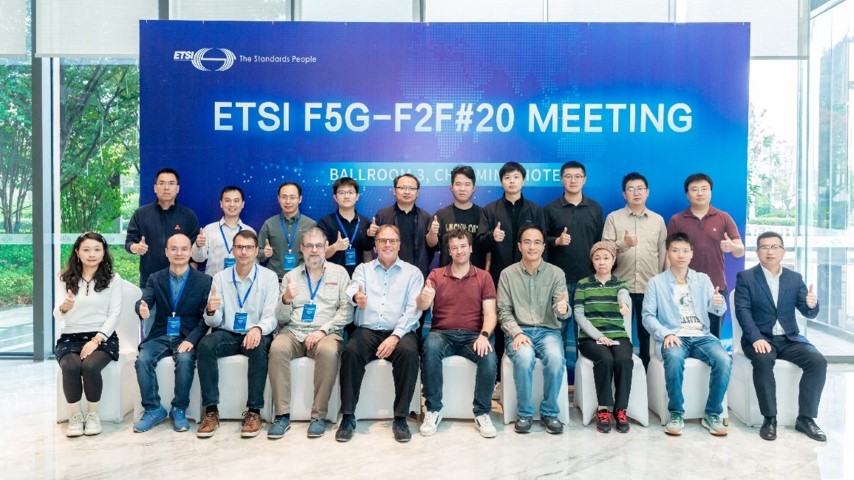
Network X 2024 took place from October 8th to 10th at the international conference centre, Paris Expo Porte de Versailles in France. ETSI, a partner of Network X, hosted the "Partner Workshop with ETSI ISG F5G" on the first day of Network X.
This workshop focused on F5G-Advanced initiatives, highlighting the latest developments and progress. It provided the participants with the status norms and the achievement made in F5G-Advanced, which will help to evolve fixed networks.
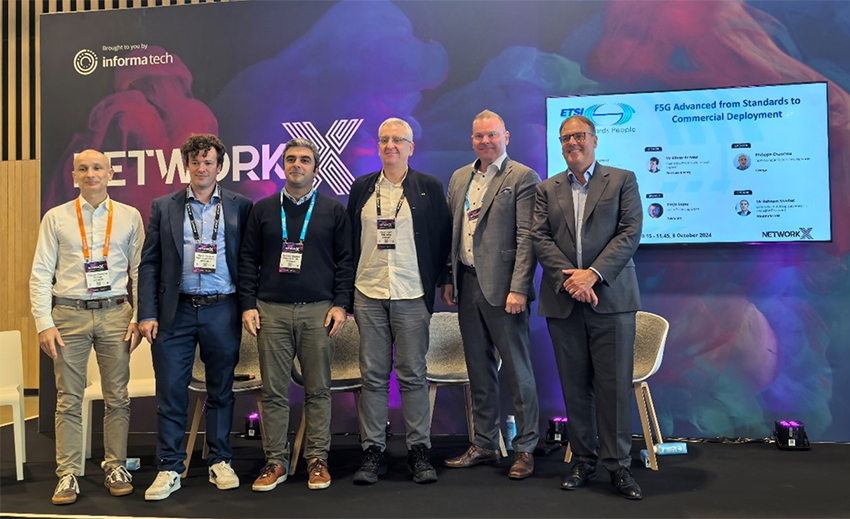
In picture are the five speakers who shared their F5G-Advanced viewpoints, plus the moderator. From left to right we have:
- Dr. Philippe Chanclou, Team Manager of Fixed Access Networks, Orange
- Dr. Olivier Ferveur, ETSI ISG F5G Chair, Post Luxembourg
- Dr. Behnam Shariati, Deputy Head of Group Data Analytics and Signal Processing, Fraunhofer HHI
- Dr. Diego Lopez, ETSI ISG ZSM Chair, Senior Technology Expert, Telefonica
- Mr. Riku Päärni, CTO, Lounea
- Dr. Marcus Brunner (moderator), ETSI ISG F5G Vice Chair, Chief Expert Standardization, Huawei
The 19th ETSI ISG F5G Plenary meeting was held in Sophia-Antipolis, France from August 27th to 30th 2024. As part of the Plenary meeting, an open session between ISG ZSM and ISG F5G was held. This is the first time these two ISGs have met together.
The ISG ZSM works on defining technical-agnostic end-to-end network and service management and operation framework and key technologies, which enables autonomous and future network. It is the goal of ISG F5G to apply the ZSM framework and its key enabling technologies, such as intent-based networking, Network Digital-Twin (NDT) and closed-loop automation, in the intelligent management and control of the F5G-A optical network.
Modern production facilities have to support on demand product customization to satisfy customer needs. One key technology to make this happen are Automated Guided Vehicles (AGVs). These are mobile transport robots, which distribute raw materials and parts on the factory shop floor and potentially among different manufacturing halls and warehouses. The navigation of the AGVs on the factory shop floor or in outdoor areas is a computationally complex task requiring significant computing resources. Cloud-based AGV navigation enables cooperation and centralized information exchange between multiple robots and AGVs.
As the number and variation of AGVs within a production facility site increases, so does the complexity of their control, for guaranteeing a seamless and orchestrated operation.

Figure 1
In the ISG F5G F2F#19 plenary meeting held in Sophia-Antipolis, France from August 27th to 30th 2024, the creation of a new Work Item (WI) for F5G-A Use Cases Release 4 was agreed. The new work item is proposed by China Unicom and has eight supporting organizations including Orange, China Telecommunications, ZTE Corporation, CTTC, Huawei Technologies France, CAICT, POST Luxembourg and CICT. Mr. Yue Sun from China Unicom is the Rapporteur of this WI.
The International Telecommunication Union (ITU) together with the European Telecommunications Standards Institute – Industry Specification Group -Fifth Generation Fixed Network (ETSI ISG F5G), the Broadband Forum (BBF), and the China Communications Standards Association – Technical Committee 6 (CCSA TC6) organized the Fourth Joint ETSI ISG F5G, BBF, CCSA TC6 and ITU-T SG15 Workshop on "FTTR" (Fibre to the room), which took place 10 July 2024 from 8:00-12:00 (EDT)/14h00 to 18h00 (CEST) in Montreal, Canada.
The use case of on-premises fibre networks, such as FTTR, was firstly described in ETSI GR F5G 002 by the ISG F5G early in 2020. Since then, the related standards have been rapidly developed by several Standard Development Organisations (SDOs). The workshop intend was to offer the opportunity to continue the discussion on FTTR and other on-premises fibre networks for all the involved stakeholders, to reach a better common understanding of the use cases, the requirements, the deployment challenges, and the best practices. This workshop facilitates the development of an FTTR standard and the cooperation of multiple SDOs, as well as the system deployment by the network operators.

ETSI GR F5G 020, F5G Advanced Use Cases; Release 3 is publishing use cases to be enabled by the F5G Advanced (F5G-A) network. The use cases in that document include services and applications for residential customer, enterprises, vertical industries, network operation optimizations, and evolved fixed end-to-end infrastructure, which were not supported by the F5G network. Use cases will aim to introduce new technical requirements for the F5G Advance network along various characteristic dimensions. The use cases will be used as input to drive the technology development and standardization of new features for F5G Advanced based on the technical requirements derived from those use cases.
The International Telecommunication Union (ITU) together with the European Telecommunications Standards Institute – Industry Specification Group -Fifth Generation Fixed Network (ETSI ISG F5G), the Broadband Forum (BBF), and the China Communications Standards Association – Technical Committee 6 (CCSA TC6) are organizing the Fourth Joint ETSI ISG F5G, BBF, CCSA TC6 and ITU-T SG15 Workshop on "FTTR" (Fibre to the room), which will take place 10 July 2024 from 8:00‑12:00 (EDT)/14h00 to 18h00 (CEST) in Montreal, Canada. This is an in-person event with remote participation.
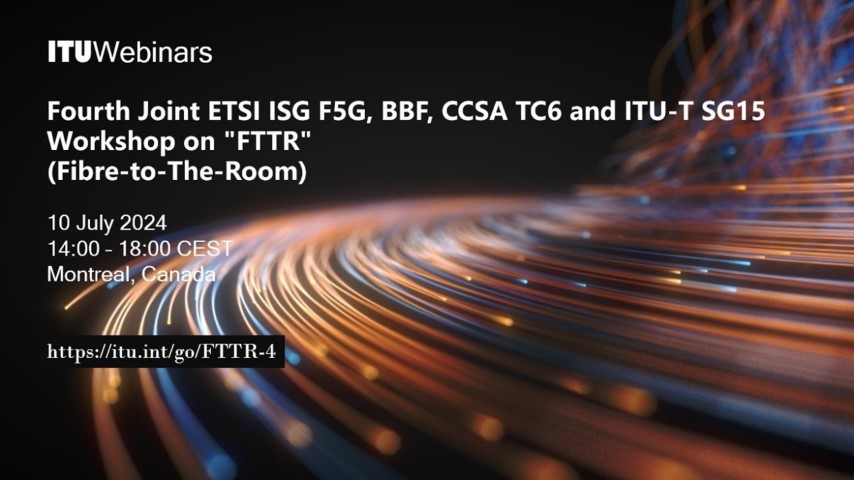
On May 28th ~ 31st 2024, the 18th ETSI ISG F5G Plenary meeting was held in Luxembourg, hosted by POST Luxembourg. Significant progress was made during the meeting.
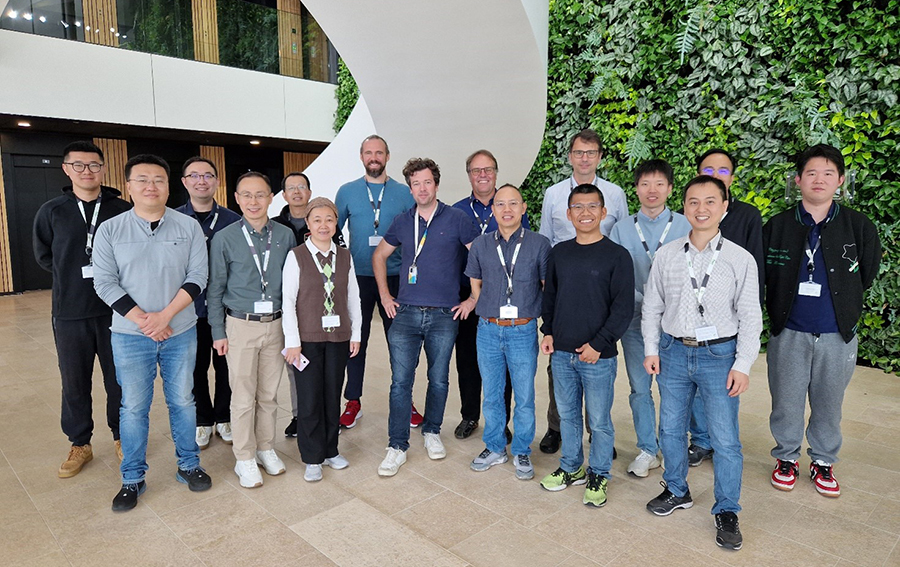
The development of the proof of concept "Visual inspection for automatic quality assessment PoC" started in May 2023 and was successfully finished in November 2023. Several goals have been set:
- implementation of a PON based industrial Edge/Cloud-based; and
- visual inspection for quality assessment of products and to demonstrate a low-latency ML‑based video processing-pipeline for end-to-end manufacturing control loop.
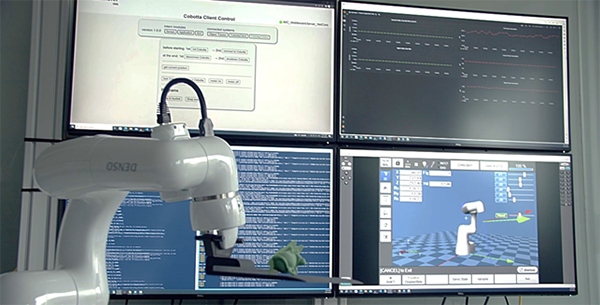
At the Mobile World Congress 2024, the Centre Tecnològic de Telecomunicacions de Catalunya (CTTC) and Huawei Technologies introduced a groundbreaking Proof of Concept (PoC) that underscores the capabilities of the ETSI Industrial Specification Group (ISG) Fifth Generation Fixed Network (F5G). This demonstration exemplified a significant leap in Fixed 5G technology, using a Virtual Reality (VR) Gaming Service for Remote Players as a practical application of the F5G Advanced (F5G-A) architecture. The F5G-A architecture exploits the optical network capacities to provide high quality transmission with ultra-low end-to-end latency, high bandwidth guarantees, and minimized jitter to ensure the Quality of Experience (QoE) for cloud-based services. This architecture promises to reshape a myriad of high-demand digital services, offering unparalleled connectivity and intelligent End-to-End (E2E) service management.
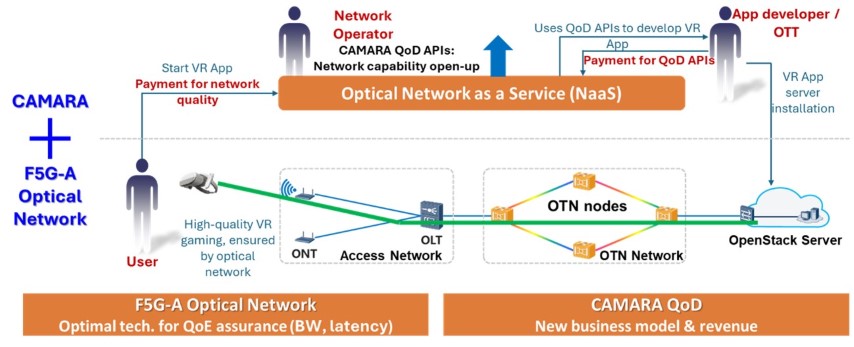
On February 20th ~ 23rd 2024, the ETSI ISG F5G #17th Plenary meeting was held in Sophia Antipolis, France. This is the first plenary meeting of the ISG F5G third term.
In the meeting, the election of F5G Chair and Vice-Chairs for the third term was held. Dr. Olivier Ferveur from POST Luxembourg was appointed the ISG F5G Chair effective immediately. Dr. Marcus Brunner from Huawei Technologies (UK) Co., Ltd. and Dr. Jialiang Jin from China Telecom were appointed the Vice-Chairs (the mandates of F5G Vice-Chairs will start on 17th April 2024).
On January 23rd 2024, an ETSI webinar "How can all-optical networks contribute to carbon transition?", was presented by ETSI ISG F5G, to disseminate the ETSI White Paper "All-optical network facilitates the Carbon Shift" published in November 2023.
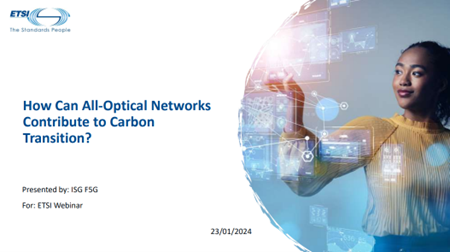
This White Paper was developed by ISG F5G to provides an overview of an all-optical network and the recent developments in optical technologies, and highlights the role of all-optical networks as a key ICT enabler to meet the UN sustainability goals.
In this webinar, there were four speakers, that included the co-editors / contributors of the White Paper, who shared their viewpoints on green all-optical networks:
- Mr. Jean-Luc Lemmens, Co-Editor, CEO IDATE
- Dr. Olivier Ferveur, F5G Acting-Chair ISG F5G, Post Luxembourg
- Dr. Xiangkun Man, Co-Editor, China Unicom
- Dr. Marcus Brunner, Liaison Officer in ISG F5G, Huawei
On November 30th 2023, an important ETSI ISG F5G Group Report was released. The title of the report is “Fifth Generation Fixed Network (F5G); F5G Advanced Generation Definition” [ETSI GR F5G 021]. This is the first report for the F5G Advanced generation in Release 3. The publication of the ETSI GR F5G 021 is a significant milestone for ISG F5G, which is steadily evolving from F5G to F5G Advanced.
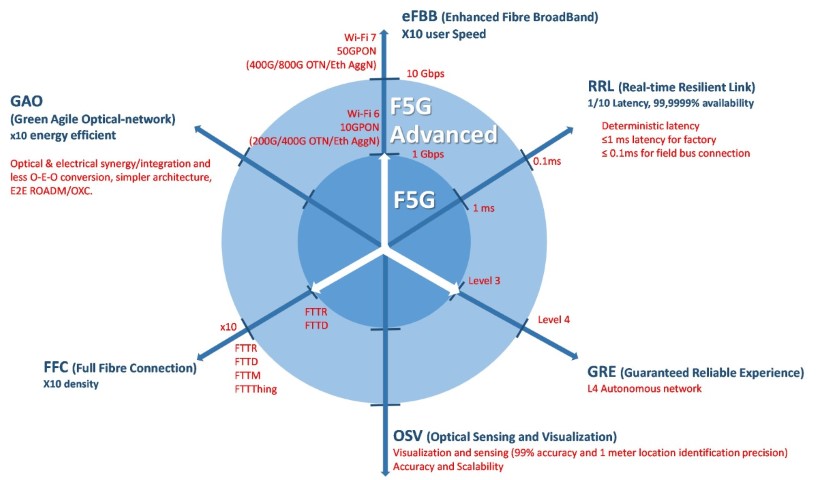
Six dimensions of F5G Advanced with enabling technologies characteristics
| 0 - Overview | 488.53 KB | 14/06/2021 | |||
| 1 - Signature formats & verification procedures | 1.16 MB | 14/06/2021 | |||
| 2- AdES Formats & Signature Validation | 1.02 MB | 14/06/2021 | |||
| 3 - Standards for TSPs issuing certificates - ETSI EN 319 401/411/412ETSI EN 319 401/411/412 | 532.43 KB | 14/06/2021 | |||
| 4 - Other Trust Application standards - REM, ERDS, preservationREM, ERDS, preservation | 1.16 MB | 14/06/2021 | |||
| 5 - TSP Supervision, Certification and Audit under eIDAS Part III | 887.71 KB | 14/06/2021 | |||
| 6 - Standards for Identity proofing - ETSI TR 119 460 / TS 119 461ETSI TR 119 460 / TS 119 461 | 597.05 KB | 14/06/2021 | |||
| 7 - Remote signing | 739.81 KB | 14/06/2021 | |||
| 8/9 - Trusted Lists & Mutual Recognition of non-EU Trust ServicesMutual Recognition of non-EU Trust Services | 2.2 MB | 14/06/2021 | |||
| Closing Remarks | 409.16 KB | 14/06/2021 |
